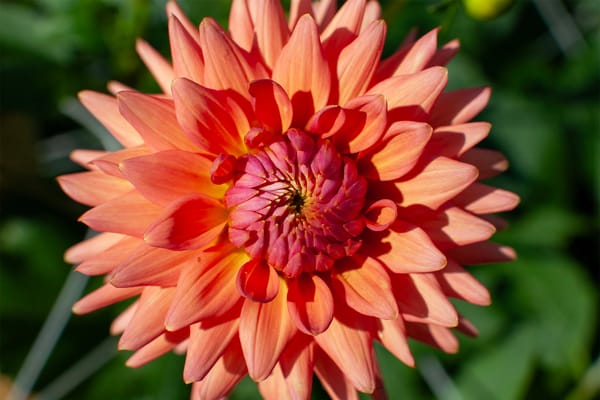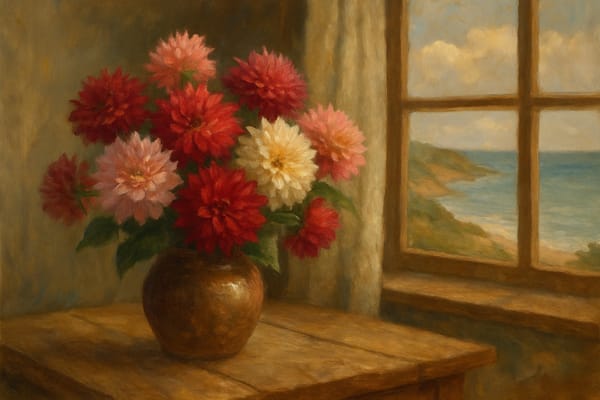From highland Mexico to the showgrounds of England, from Japanese art to American flower festivals, few blooms have captured the human heart like the dahlia. This vibrant, many-petalled wonder carries a global story—one that twines together ancient civilizations, horticultural obsessions, artistic inspiration, and enduring cultural symbolism. To trace the dahlia’s journey is to follow a living thread of beauty, resilience, and human creativity.
Native Roots: The Aztec Flower of Strength
Long before the dahlia became a darling of Victorian glasshouses or adorned global festivals, it thrived wild in the volcanic mountains of Mexico and Central America. The Aztecs knew this plant not just for its radiant flowers but also for its many uses. Known in Nahuatl as acocoxochitl—“water pipe flower”—dahlias served both practical and ceremonial roles. Their hollow stems were fashioned into water conduits, while their tubers provided a starchy food source. Some indigenous groups used them medicinally, recognizing their anti-inflammatory properties.
The dahlia’s cultural significance endures today as Mexico’s national flower, a symbol of strength, grace, and ancestral pride. Nowhere is this more vivid than during the Day of the Dead, where dahlias bloom in vibrant offerings, honoring loved ones and linking the living with generations past.
The European Obsession: From Curiosity to Cult Classic
Spanish explorers first introduced dahlias to Europe in the late 18th century, captivated by the plant’s showy form and edible tubers. Yet it was the flower’s visual allure that soon eclipsed its culinary potential. By the 19th century, dahlias had ignited a horticultural craze across Europe—especially in France, the United Kingdom, and the Netherlands.
In Victorian England, dahlias became the floral embodiment of dignity, commitment, and lifelong bonds. To gift a dahlia was to offer a silent message of loyalty and respect. Gardeners, meanwhile, vied to breed ever more intricate forms and radiant colors, fueling a dahlia mania that gripped high society and humble growers alike.
In the Netherlands, with its ideal cool summers and rich soils, dahlia cultivation took on a commercial scale. Dutch growers refined propagation techniques, staged lavish exhibitions, and turned the dahlia into a global horticultural export.
Across the Pacific: The Dahlia in Japan and Asia
In Japan, where flower symbolism is woven deeply into art and daily life, dahlias found a place among beloved blooms. In Hanakotoba, the Japanese language of flowers, dahlias represent kindness, good taste, and the elegant transformation of character. They are celebrated for their grace and harmonious form, often featured in both traditional gardens and contemporary art.
China too, though not historically a center of dahlia cultivation, has embraced the flower’s symbolic resonance—associating it with noble character, creative expression, and enduring beauty in modern garden design.
The American Connection: Festivals and Floral Fame
In the United States, the dahlia journeyed from botanical curiosity to cultural staple. Particularly in the Pacific Northwest, with its temperate climate and fertile soils, dahlias flourished in both home gardens and commercial fields. Cities like Portland, Denver, and Long Island became centers of dahlia celebration, hosting festivals where growers showcased astonishing displays of variety and form.
The American Dahlia Society, alongside numerous local chapters, nurtures both competitive growing and community education. In American floriography, dahlias stand for creativity, resilience, and gratitude—qualities mirrored in their generous bloom habit and dazzling diversity.
Festivals of Colour: Global Celebrations of the Dahlia
Across the world, festivals dedicated to dahlias bring communities together in a shared appreciation of floral artistry and cultural heritage:
- Mexico’s National Dahlia Festival honors the flower’s deep indigenous roots with parades, exhibitions, and traditional crafts.
- The Netherlands’ Amsterdam Dahlia Festival turns parks and gardens into living canvases, blending blooms with art and design.
- Switzerland’s Morges Dahlia Festival lines Lake Geneva with over 2,000 dahlia plants, inviting public participation and celebration.
- Japan’s Tokyo Dahlia Show merges horticulture with traditional aesthetics, showcasing the flower’s grace and symbolic meaning.
- England’s National Dahlia Society Shows uphold the traditions of competitive growing, featuring heritage varieties and contemporary champions.
- America’s Portland Dahlia Festival and other regional events combine field displays, floral competitions, and family festivities.
These festivals, rich with color and communal pride, reflect how a single flower can unite people across borders and traditions.
Folklore, Art, and the Secret Language of Flowers
The dahlia’s intricate forms and vibrant colors have inspired countless artists, poets, and writers. In Victorian times, when the “language of flowers” conveyed sentiments too delicate for words, dahlias stood for enduring bonds and elegant strength. Painters captured their fleeting beauty, poets likened their layered petals to the complexities of human emotion, and designers used their forms in everything from textiles to jewelry.
Folklore, too, imbues the dahlia with meaning. Aztec legends link the flower to tales of courage and transformation. In modern narratives, it remains a symbol of inner strength, positive change, and the resilience of both plant and spirit.
The Living Symbolism of the Dahlia
Today, the dahlia’s symbolism continues to evolve—resonating with themes of diversity, grace under pressure, and the beauty of life’s unique journey. Whether as a gift between friends, a bride’s bouquet, a festival bloom, or a cherished garden favorite, the dahlia speaks a universal language of creativity, resilience, and joy.
A Bloom That Belongs to the World
In every petal of the dahlia lies a story—of ancient peoples, adventurous explorers, devoted breeders, and passionate gardeners. Its journey from the mountains of Mexico to the world’s grandest stages tells of a flower that transcends mere ornament, becoming a bridge between cultures, a muse for artistry, and a living testament to nature’s power to inspire.
Wherever it grows—whether in a small Cornish garden, a Tokyo park, or a Mexican festival—the dahlia invites us all to share in its enduring story, a tale as vibrant and layered as the flower itself.











